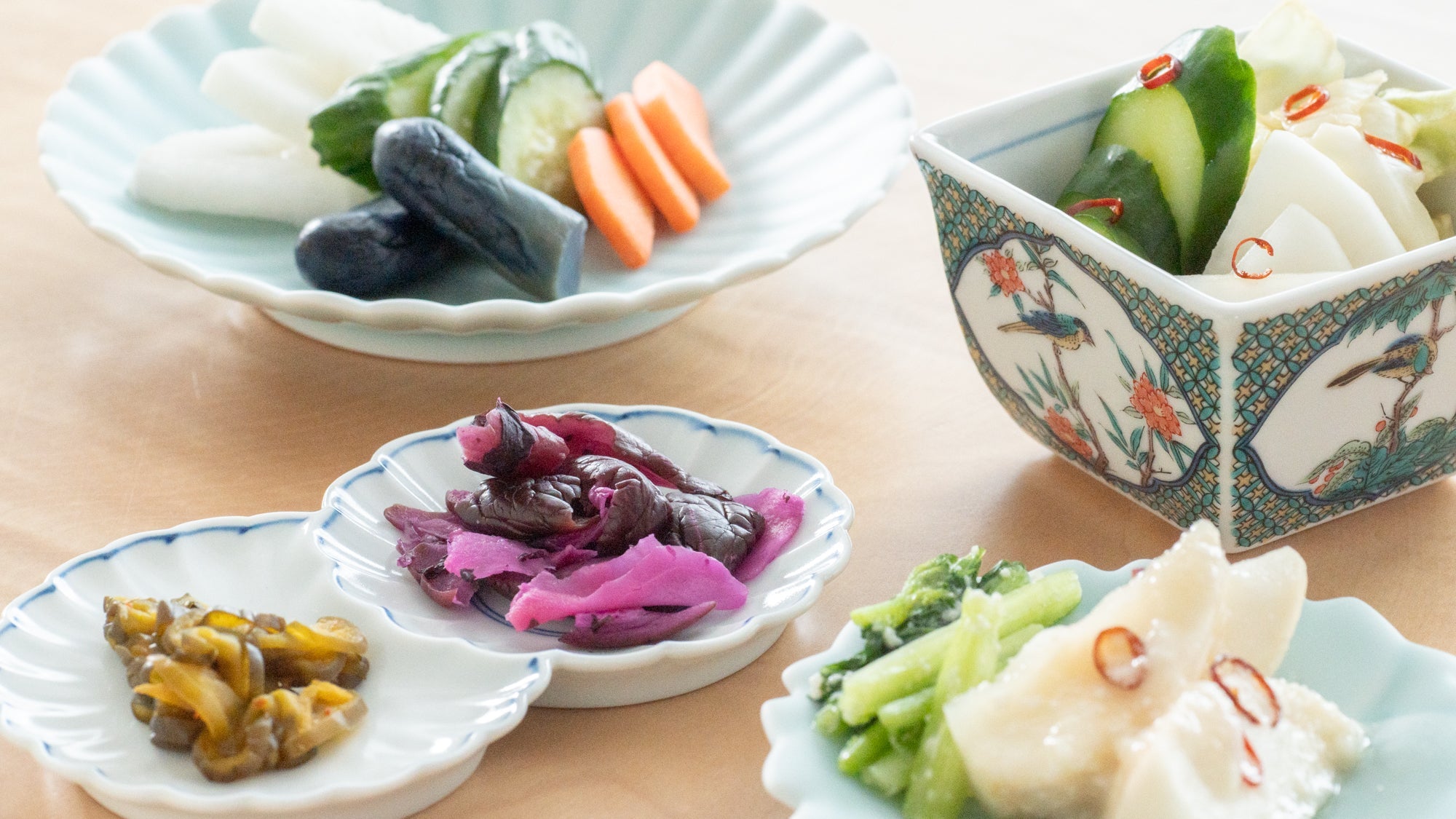
The Flavor of Ages: Japanese Pickles
Written by Team MUSUBI
From the bustling markets of Tokyo to the tranquil countryside of Kyoto, tsukemono, “Japanese pickles,” are a cherished culinary tradition that transcends time. These vibrant and flavorful delights are more than just condiments; they are a testament to Japan's rich cultural heritage. Each bite offers a journey through history, capturing the essence of seasonal produce preserved with ancient techniques.
Join us as we delve into the world of tsukemono, exploring the unique flavors, textures and manufacturing methods that make these pickles a timeless gift from the past to the present. Discover how these humble creations continue to enchant and inspire, adding a touch of history to every meal.
Table of Contents
What is Tsukemono?

Over 2,000 years ago, the Japanese began preserving food using salt. By the Edo period (1603 CE–1868 CE), the increase in eateries led to the establishment of the pickling industry and books detailing pickling methods were published.

Tsukemono can be categorized in various ways based on different criteria. According to the type of pickling bed, there are shiozuke (salt), shoyuzuke (soy sauce), suzuke (vinegar), nukazuke (rice bran), misozuke (miso), kojizuke (rice malt), and kasuzuke (sake lees). Alternatively, tsukemono can be classified by the ingredients used, or their regional origins, as each area has its distinct flavors and methods.
Different Types of Japanese Pickles
Asazuke
One of the most common types of pickles in Japan is asazuke. It means "lightly pickled," a quick-pickling method that requires minimal fermentation time, often just a few hours to a day. Vegetables such as cucumbers, cabbage, and daikon are typically used. They are salted and sometimes combined with other flavorings like ginger, garlic, or chilies.
The result is a crisp, refreshing pickle that retains much of the vegetable's natural flavor and crunch. Asazuke is ideal for those who prefer a milder pickled taste and a quicker preparation process.

Asazuke can be made with varying amounts of salt and additional seasonings to create a range of flavors. If you stroll through the streets of Kyoto in the summer, you'll often see people holding whole cucumbers on sticks. This is also a form of asazuke. Lemon is sometimes added during the pickling process to enhance the overall flavor, making it even more refreshing and perfectly suited for summertime consumption.
Nukazuke



One of the key aspects of making delicious nukazuke is to regularly hand-mix the nukadoko and the vegetables within it. The unique microorganisms present on each person's hands contribute to slight variations in flavor, making the taste of nukazuke from each household unique. This distinct flavor often becomes a cherished memory of home for many people.
Shibazuke

Traditionally, it was called murasakihazuke, meaning "purple leaf pickle," because it is made by pickling vegetables with purple shiso leaves and salt. The name has since evolved to shibazuke, highlighting its distinctive purple color and tangy flavor imparted by the shiso leaves.

This kind of pickle traditionally includes cucumbers, eggplants and myoga “Japanese ginger” that are salted and fermented together with purple shiso leaves. The result is a slightly tangy and refreshing pickle with a hint of shiso's aromatic flavor. Because of its vibrant color, shibazuke is often included in Japanese bento boxes, adding a visually appealing and flavorful touch to the meal.
Kojizuke


How to Enjoy Tsukemono



The subtle floral flavor of sakura no shiozuke pairs wonderfully with sweets. Incorporate them into traditional Japanese sweets like mochi, or use them to decorate Western-style cakes and pastries. The blossoms add a unique taste and a stunning visual element to any dessert.
These pickled blossoms can also be enjoyed as a tea. Known as sakurayu, this tea is made by steeping the salt-pickled cherry blossoms in hot water. The resulting drink is not only beautiful to look at but also offers a mild, soothing flavor, perfect for a relaxing moment.
Japan is often referred to as a country of longevity, a distinction that owes much to a balanced diet rich in seasonal vegetables and fermented foods. The consumption of tsukemono, with its unique dietary benefits and preservation techniques, exemplifies the wisdom of the Japanese in adapting to their environment. This tradition not only preserves nature's bounty but also contributes significantly to the nation's health and longevity.







Leave a comment
This site is protected by hCaptcha and the hCaptcha Privacy Policy and Terms of Service apply.